
The author of this travelogue, Maturin M. Ballou, was an American journalist and publisher born in Boston, Massachusetts (Winzeler, Boston Athenaeum). He visited many places in the world throughout his life, one of them being Cuba. In his travelogue, Ballou introduces Cuban history and politics to a foreign, English-speaking audience. As it was published in 1854, Cuba was still under the Spanish imperial rule. In the first chapter, the author focuses on the early history of Cuba, the tensions between the Spaniard colonizers and the natives, etc. Slavery, which is mentioned in this chapter as well as in others, is a prominent theme in this travelogue. Although the author’s POV seems like he is writing against the Spaniards by portraying their colonial viciousness to a wider audience, it is more complicated in reality as we also see a racist depiction of the natives in his writing. Also, another fact to consider is that there was a long-term conflict going on between the US and the Spanish empire, which might have influenced Ballou’s political intentions behind the travelogue as well.
Ballou’s racial inferiorization of the Cuban natives can be seen throughout the chapter. When discussing the first encounter between the Spaniards and the natives, Ballou describes them as “hospitable, inoffensive, timid… who were soon reduced to a state of slavery” (Ballou, 10). He portrays them as naïve by showing evidence of their cordiality towards the colonizers when they arrived the first time (Ballou, 12). As they became the victims of slavery, the Spaniards gave them hard labor which they were not accustomed to as they were considered to be “lazy, fragile”, and the Spaniards had to replace them with “hardier characters”, i.e- African slaves (Ballou, 17). Here, we see this infantilization of the natives going on in Ballou’s writing, which creates a sympathy among the audience of this book while instilling the idea of racial superiority of the Spaniards within them.
Going back to Ballou’s political intentions behind his account, this gives us an early glimpse of Spanish-American tensions, which eventually resulted in the Spanish-American war in 1898 where the US took control over Cuba (“Spanish-American War”, History.com). The conflict between two imperial forces and their own political agendas gave rise to the conception of the “fragile, naïve” Cubans who were desperately in need of a colonizing force. Ballou’s travelogue, along with many other travel accounts, served the role of portraying this colonial framework to a wider audience (specifically those who were in power) to justify colonial rule.
Sources:
Winzeler, Alexandra (May 2014). “Maturin Murray Ballou”. Boston Athenæum.
Ballou, Maturin Murray. History of Cuba; or, Notes of a Traveller in the Tropics. Being a Political, Historical, and Statistical Account of the Island, from Its First Discovery to the Present Time. Boston Phillips, Sampson, 1854.
Editors, History com. “Spanish-American War.” HISTORY. Accessed February 18, 2022.
